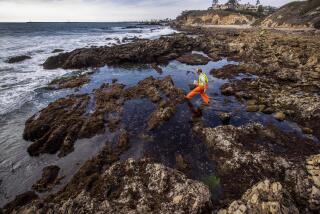Nassco Says It’s Poised for Double-Hull Work
- Share via
Executives of National Steel & Shipbuilding Co., which this month won the first major commercial shipbuilding contract awarded to a U.S. shipyard since 1984, believe the firm is well positioned to win additional contracts, if legislation mandates the use of double hulls or double bottoms on oil tankers operating in U.S. ports.
“Nassco traditionally has been the predominant commercial shipbuilder in the U.S.,” said Fred Hallett, company vice president. While it is unable to compete with “heavily subsidized” shipyards in foreign countries, Hallett said, Nassco, which has trimmed its operating costs, is extremely competitive with the handful of remaining domestic shipyards.
Nassco’s new stance came into play earlier this month when San Francisco-based Matson Navigation awarded the firm a $129-million contract to build a 713-foot container ship, the first commercial ship to be built at the Nassco yard on San Diego Bay since the Exxon Valdez was completed in 1986. The Valdez ran aground last spring in Alaskan waters, causing the nation’s worst oil spill, and is now being repaired at a Nassco dock.
Bids to build the container ship, which will operate between West Coast ports and Hawaii, were limited to U.S. shipbuilders because of the Jones Act, a World War II-era law that prohibits foreign-built ships from hauling cargo between U.S. ports. The law does not apply to ships that, for example, haul fuel oil from Indonesia to the United States.
If the Jones Act remains in force, Nassco stands a good chance of outbidding its domestic competitors.
Congress is now considering two bills that could eventually require new tankers to have double hulls or double bottoms. A House bill would require double hulls or bottoms for new tankers and retrofitting of existing tankers. A Senate bill would direct the Department of Transportation to study whether double hulls would reduce the likelihood of spills, but would not require retrofitting of existing tankers.
The Senate approach frustrates Hallett because “we’ve had repeated studies during the past 10 years, and every time (a spill occurs) we get another study.” But some shipping industry observers believe legislators will probably mandate the use of double-hulled or -bottomed ships.
Shortly after the American Trader spilled almost 400,000 gallons of crude oil into the ocean off Huntington Beach on Feb. 8, Arthur McKenzie, president of the Tanker Advisory Center in New York, said the disaster had put “irresistible pressure” on legislators.
“This is it,” McKenzie said after the spill, which occurred less than a year after the Valdez spill. He called the new spill the “icing on the cake. . . . Now we’re going to get double bottoms.”
U.S. shipbuilders would have little trouble designing and building double-hulled or double-bottomed tankers, Hallett said.
“The technology . . . is well within our capabilities. There are already six double-hulled ships, so clearly they are technologically feasible.” Similarly, U.S. shipbuilders could use the technology to retrofit existing tankers, Hallett said.
He acknowledged that U.S. shipyards have a vested interest in requiring the nation’s oil companies to use newly built, double-hulled or double-bottomed ships on runs between U.S. ports.
“Shipbuilders are facing a very difficult future because U.S. Navy shipbuilding programs are going away,” Hallett said. U.S. shipbuilders believe that building ships with double hulls or double bottoms “would be both environmentally (safe) and give shipyards the methodology of changing from military to civilian yards. You have to appreciate the fact that without some kind of new construction, there’s no future for shipbuilding in the U.S.”
While shipbuilders support construction of a new generation of tankers, oil companies oppose the double-hull legislation. Members of an industry group representing oil companies and ship owners argue that it would be “ill-advised” to require double hulls or double bottoms because “studies on the effectiveness of these and other measures are still in progress.”
However, Hallett maintained that it is clearly time to replace the nation’s aging “Jones Act fleet . . . (because), according to the typical life span of a tanker, you’d start to see ships being replaced at about 20 years.” He argued that existing ships should not be “grandfathered,” because “you’d see people take 30-year-old ships and try to extend their life spans in any way possible.”
OIL TANKERS IN THE JONES ACT FLEET
SINGLE-HULLED SHIPS: 109 total
30 yrs or older: 37
20 to 30 yrs: 31
15 to 20 yrs: 26
1 to 15 yrs: 15
DOUBLE-BOTTOMED SHIPS: 30 total
1 to 15 yrs: 26
15 to 20 yrs: 4
DOUBLE-HULLED SHIPS: 6 total
1 to 15 yrs: 5
15 to 20 yrs: 1
Source: Shipbuilders Council of America
More to Read
Inside the business of entertainment
The Wide Shot brings you news, analysis and insights on everything from streaming wars to production — and what it all means for the future.
You may occasionally receive promotional content from the Los Angeles Times.










